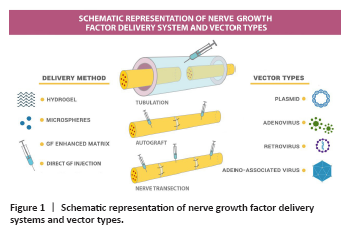周围神经损伤
-
Figure 1|Schematic representation of nerve growth factor delivery systems and vector types.

To this end, new techniques have been studied based on delivery of active molecule (affinity-based delivery) (Wood et al., 2009). To deliver therapeutic compounds or to create the microenvironment for more efficient regeneration, a huge variety of hydrogels, microspheres, acellular matrices, three-dimensional “scaffolding”, and fibrin glues of biological and synthetic origin are used, as well as various types of vectors for delivery (Figure 1). The design of neural conduits requires information on neural architecture, type of injury, nerve cells, scaffold materials, neural growth factors to add and optimize the mechanical properties of the conduit. 3D Biorinated Peripheral Nerve Tubes serve as nerve grafts to fill in the gaps in destroyed nerve bodies, making the peripheral nerve canals alive (Soman and Vijayavenkataraman, 2020). Over the past decades, strategies have been developed involving the use of biopolymers, cells, growth factors and physical stimuli, which have led to the development of various nerve conductors (NGCs), from simple hollow tubes to complex pipelines involving one or more landmarks (Sarker et al., 2018).